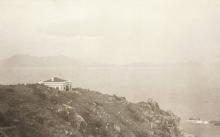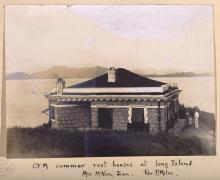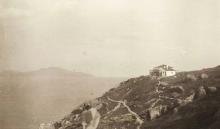The location of the marker is a guess. The 1938 Map shows the New Zealand Presbyterian Mission owned houses 9 & 10. I think the marker is on the site of house 10, but I'm not sure. If you know where the house is, please let me know.
Here are notes about the house from the AMO's "Brief Information on No Grade Items":
Historic Building Appraisal
Former Cottage of the Presbyterian Church of New Zealand, Fa Peng, Cheung Chau
Historical Interest
The Former Cottage was built in 1912 as a summer retreat for missionaries of the Presbyterian Church of New Zealand (also known as Canton Villages Mission). The Mission came into being in 1901 when the Rev. George McNeur first set foot in Canton (Guangzhou 廣州) with the view of establishing a self-supporting, self-governing and self-propagating church.
During the Japanese Occupation, the Cottage (in Chinese: 長洲花坪前新西蘭長老會別墅) suffered considerable damage and was renovated in 1947. With the departure of church missionaries from China after 1949, the Presbyterian Church of New Zealand came to an end in 1951 and the cottage was sold. It now belongs to the Church Body of the Chinese Anglican Church in Hong Kong (香港聖公會管業委員會). It is vacant nowadays.
Architectural Merit
The cottage is a single-storey structure constructed of granite blocks. The entrance lobby is divided from the central living room by a column and two arches. Bedrooms and bathrooms are situated on either side of the living room. A chevron shaped annex at the rear contains the kitchen, pantry and servants’ rooms. Encaustic patterned floor tiles are the only decorative feature internally. Externally, the walls can be seen to be built of coursed granite, window openings have projecting hood mouldings for weather protection, and a heavy convex cornice runs around the building. Doors are framed, ledged, braced and battened wooden doors and windows are simply designed folding wooden casements. The cottage is now in a very dilapidated condition and cannot be said to have a great deal of architectural merit.
Rarity & Built Heritage, Value & Authenticity
The cottage, which is now getting on for 100 years old is quite a rarity on Cheung Chau. During the period of Japanese Occupation (1941-1945), it was looted by the Chinese rabble, and every vestige of woodwork was carried away. It was found virtually uninhabitable after the war and a major rehabilitation project was undertaken in 1947. Nevertheless, the original plan and the basic structure seem to be authentic. An L-shaped separate outhouse with rendered walls (purpose unknown) is located at the north-west corner of the cottage.
Social Value & Local Interest
The historical social value of the cottage lies in its link with the missionaries of the Presbyterian Church of New Zealand in Hong Kong. Its establishment in the early 1910s, soon after Cheung Chau was included in the map of the newly acquired “New Territories” in 1898, signified the expansion of Western influences on the island. As a relic of colonial and missionary days and remnant of the past, the cottage has some local interest.
Group Value
The Cottage together with other historic buildings on Cheung Chau – e.g., Yuk Hui Temple (玉虛宮), Hung Shing Temple (洪聖廟), Shui Yuet Temple (水月宮), Sai Wan Tin Hau Temple, Cheung Chau Police Station (長洲警署), Cheung Chau Government Secondary School (長洲官立中學) and Cheung Chau Fong Pin Hospital (長洲方便醫院) – have group value from a cultural and heritage point of view.
Adaptive Re-use
It is apparent that the cottage has been abandoned and derelict for some time. The cottage is not very capacious and probably the best adaptive use for it is that for which it was originally intended – a summer retreat a holiday home. Whether or not this is a practical proposition depends on the availability of services such as water supply, electricity and main drainage.



Comments
House #10
Hi There,
Checked Google Map and found the latest view showed someone seemed to be opening up this site and the original perimetre appeared to be seen from above.
T
House #10
Some individual houses in the European Reservation appear at: https://pcanzarchives.recollect.co.nz/nodes/search?keywords=cheung%20chau&type=all&viewtype=grid
The house(s) belong to the Presbyterian Church of New Zealand.
Re: Garden of Prayer
Hi there,
A recent browse of Google Maps revealed the site is now called "Garden of Prayer", managed by the HKSKH (Anglican) House of Prayer nearby.
T
ps I vaguely remember I went past the entrace foot path around 10 to 15 years ago. Back then, the site was already much over grown, with a string barrier being used at the gateway saying something like Private, no trasspassing. Cannot see through the footpath at all. Unable to verify when the cottage was demolished. That we likely have to check with SKH.
The google map link above clearly showed the site had been cleared.